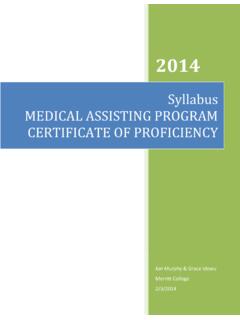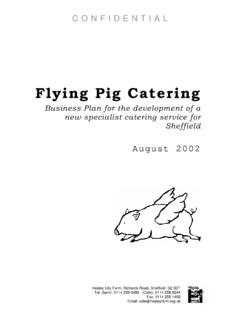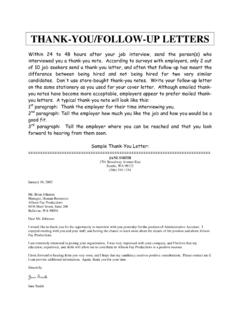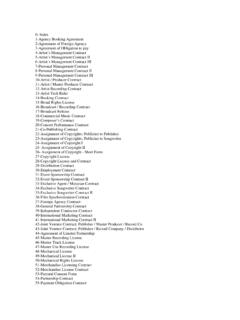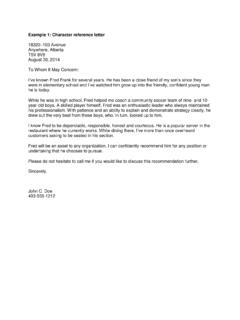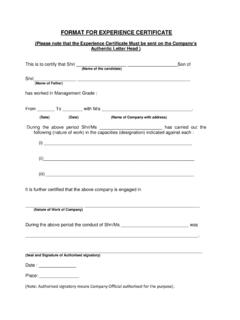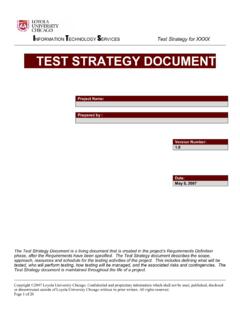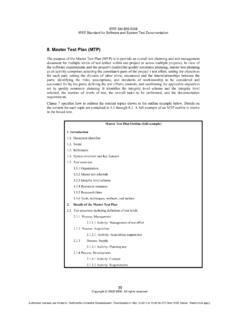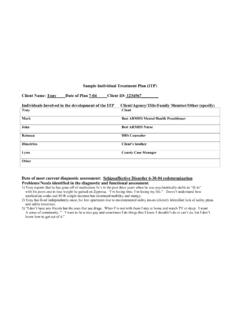Transcription of Field Trip Report
1 Marine Studies 2004 Sample assessment instrument and student responses Field trip Report : Marine biology This sample is intended to inform the design of assessment instruments in the senior phase of learning. It highlights the qualities of student work and the match to the syllabus standards. Criteria assessed Knowledge and understanding Information processing and reasoning Skills Assessment instrument The response presented in this sample is in response to assessment tasks. Time 2-day Field trip to collect data 2 lessons in laboratory time to complete water analysis 1 lesson for Report writing Conditions Group and individual work for data collection in the Field and laboratory Individual workbooks and written Report Written Report under test conditions, notes and work books allowed Task A Food webs 1. Draw a mangrove food web representing the species that are typically present in the mangrove system.
2 2. Annotate your diagram to show the feeding levels: producers, consumers (1st, 2nd, 3rd order), decomposers. 3. Using the organisms in your food web, complete the table to identify each organism as an autotroph, herbivore, carnivore, omnivore, detritivore or saprotroph. 4. Which feeding level is the most abundant? 5. Water ecosystems often have a food web described as an inverted pyramid (greater biomass of consumers than producers). Explain how this can be a functioning ecosystem. 6. Describe any associations that may exist between the organisms found in the mangrove. Examples of associations could include: predator prey, mutualism, competition, commensalism, parasite host. 7. Choose two organisms you have observed in the mangroves and describe the features that help it survive in this environment. You may include diagrams in your explanation. 8. The popularity of hermit crabs for hobbyists and pet owners has seen large numbers of hermit crabs being taken from the mangroves.
3 Predict the impact this will have on the mangrove ecosystem. Refer to your food web to support your claims. 2 | Marine Studies 2004: Sample student assessment and responses Task B Keys 9. Locate the three mangrove species and draw sketches of the features of each. Use the key to identify the species to which they belong. 10. Using the key in appendix A as a model, and your observations in the Field , develop a dichotomous key that can be used in the Field to identify the three mangrove types, including any extra features you have observed. Task C Distribution 11. Explain any patterns you have identified for the distribution of the three mangrove types. 12. Sketch the area from the road to the sea to represent the distribution of mangrove species and other vegetation. Include a key to represent the species identified. Indicate the location of your transect and three quadrats. 13. Choose three locations along your transect and sketch a quadrat for each.
4 Mark the location of your quadrats on your transect. Indicate the size of the quadrat and include a key. Task D Zonation 14. Draw a profile diagram from the low-water mark to the high-water mark. Label the zones that can be seen, using the correct terminology. 15. Describe the features you have used to distinguish each zone. 16. Choose a rock pool and sketch the distribution of organisms within and around it. Use the information in appendix B to identify any unfamiliar organisms. Include a key. 17. Describe the adaptations (structural, functional or behavioural) that influence the distribution of the organisms identified. Task E Abiotic factors 18. For each of the five crab-pot sites, measure or describe the abiotic factors. Complete the table. 19. Explain two potential problems caused by using crab pots for collecting data. Task F Report (in-class task) On the Field trip, you recorded information about a range of abiotic factors.
5 Water samples were collected and analysed in the laboratory to measure salinity, nitrogen and phosphorus levels, and total solids. From this information write a Report relating the pot sites to aspects of water quality, and the chances of finding crabs in the area. Your Report should: relate your Field data to the chances of finding crabs at particular pot sites determine the most likely factor/s that affect crab numbers at particular sites suggest a reason for changes (if they occur) in the abiotic factors at the different depths. Queensland Studies Authority February 2012 | 3 Instrument-specific criteria and standards Student responses have been matched to instrument-specific criteria and standards; those which best describe the student work in this sample are shown below. For more information about the syllabus dimensions and standards descriptors, see Standard A Standard C Knowledge and understanding The student work has the following characteristics: The student work has the following characteristics: Recalling and comprehending subject matter: recalling a range of marine biology subject matter in all sections of the course explaining simple and complex relationships among marine biology ideas and concepts.
6 Recalling and comprehending subject matter: recalling simple marine biology subject matter identifying and describing relationships among marine biology ideas and concepts. Information processing and reasoning The student work has the following characteristics: The student work has the following characteristics: Planning and conducting investigations collecting and organising data in forms appropriate to the task. Interpreting and evaluating information and ideas critically analysing to establish relationships in marine biology Field data and observations Communicating information and ideas coherently and effectively, using and exploiting a range of generic structures for communicating Field observations - using vocabulary and language conventions effectively and with discrimination Planning and conducting investigations collecting data within identified categories.
7 Interpreting and evaluating information and ideas identifying simple relationships and in marine biology Field data and observations Communicating information and ideas coherently, following prescribed generic structures for communicating Field observations using vocabulary and language so that meaning is clear. Skills The student work has the following characteristics: The student work has the following characteristics: Performing manipulative skills in integrated tasks: - performs a range of integrated task sequences safely, efficiently and accurately, modifying procedures where necessary to complete activities without significant faults. Performing manipulative skills in integrated tasks: - performs a range of integrated task sequences safely, making straightforward modifications to procedures where necessary to complete activities. Note: Colour highlights have been used in the table to emphasise the qualities that discriminate between the standards.
8 Key: Qualitative differences across the standards Cognitive processes demonstrated in the response 4 | Marine Studies 2004: Sample student assessment and responses Indicative response Standard A The annotations show the match to the instrument-specific standards. Comments Some sections of the student response are highlighted to identify where aspects of the criteria might be found, but this does not demonstrate the only instances where the standard is demonstrated within the response. Explaining simple and complex relationships among marine biology ideas and concepts Collecting and organising data in forms appropriate to the task Queensland Studies Authority February 2012 | 5 Comments Explaining simple and complex relationships among marine biology ideas and concepts Recalling a range of marine biology subject matter in all sections of the course 6 | Marine Studies 2004: Sample student assessment and responses Comments Explaining simple and complex relationships among marine biology ideas and concepts Only one diagram was included to demonstrate student response.
9 Interpreting and evaluating information and ideas. Collecting and organising data in forms appropriate to the task Queensland Studies Authority February 2012 | 7 Comments Critically analysing to establish relationships in marine biology Field data and observations Collecting and organising data in forms appropriate to the task 8 | Marine Studies 2004: Sample student assessment and responses Comments Collecting and organising data in forms appropriate to the task Recalling a range of marine biology subject matter in all sections of the course Explaining simple and complex relationships among marine biology ideas and concepts Queensland Studies Authority February 2012 | 9 Comments Collecting and organising data in forms appropriate to the task Explaining simple and complex relationships among marine biology ideas and concepts 10 | Marine Studies 2004: Sample student assessment and responses Comments Collecting and organising data in forms appropriate to the task Recalling a range of marine biology subject matter in all sections of the course Queensland Studies Authority February 2012 | 11 Comments Critically analysing to establish relationships in marine biology Field data and observations Recalling a range of marine biology subject matter in all sections of the course Across all parts of the Field Report the student communicates: coherently and effectively, using and exploiting a range of generic structures for communicating Field observations using vocabulary and language conventions effectively and with discrimination.
10 When performing Field and laboratory activities the student: performs the integrated task sequences safely, efficiently and accurately, modifying procedures where necessary to complete activities without significant faults. 12 | Marine Studies 2004: Sample student assessment and responses Indicative response Standard C The annotations show the match to the instrument-specific standards. Comments Identifying and describing relationships among marine biology ideas and concepts Collecting data within identified categories Queensland Studies Authority February 2012 | 13 Comments Identifying and describing relationships among marine biology ideas and concepts Recalling simple marine biology subject matter Identifying and describing relationships among marine biology ideas and concepts 14 | Marine Studies 2004: Sample student assessment and responses Comments Collecting data within identified categories Queensland Studies Authority February 2012 | 15 Comments Identifying simple relationships and in marine biology Field data and observations Collecting data within identified categories 16 | Marine Studies 2004.
